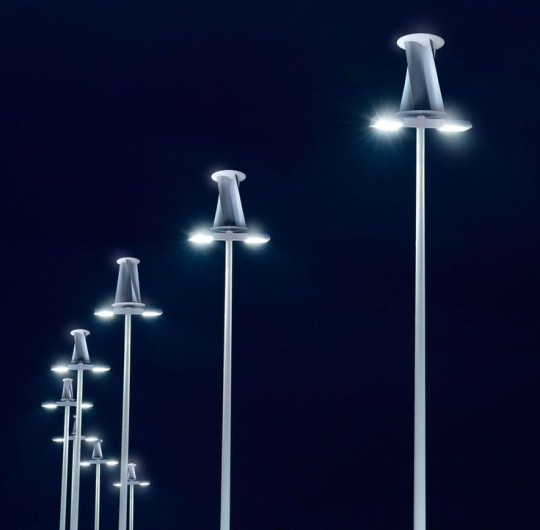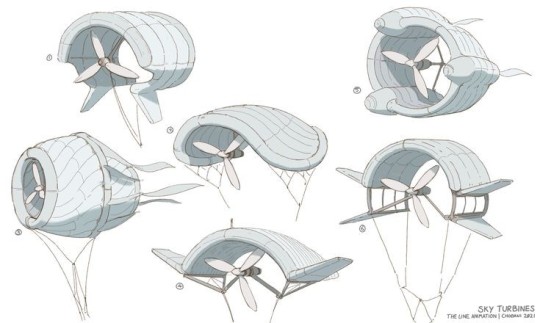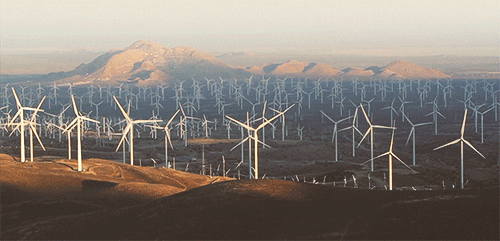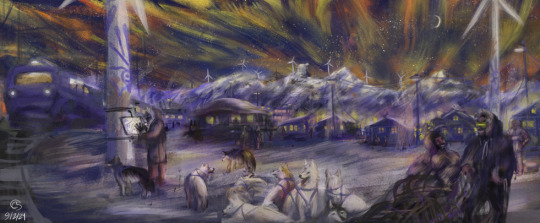#wind power
Note
hey, how do you cope with people saying we only have a small amount of time left to stop the worst effects of climate change? no matter how hopeful and ok i am, that always sends me back into a spiral :(
A few different ways
1. The biggest one is that I do math. Because renewable energy is growing exponentially
Up until basically 2021 to now, all of the climate change models were based on the idea that our ability to handle climate change will grow linearly. But that's wrong: it's growing exponentially, most of all in the green energy sector. And we're finally starting to see proof of this - and that it's going to keep going.
And many types of climate change mitigation serve as multipliers for other types. Like building a big combo in a video game.
Change has been rapidly accelerating and I genuinely believe that it's going to happen much faster than anyone is currently predicting
2. A lot of the most exciting and groundbreaking things happening around climate change are happening in developing nations, so they're not on most people's radars.
But they will expand, as developing nations are widely undergoing a massive boom in infrastructure, development, and quality of life - and as they collaborate and communicate with each other in doing so
3. Every country, state, city, province, town, nonprofit, community, and movement is basically its own test case
We're going to figure out the best ways to handle things in a remarkably quick amount of time, because everyone is trying out solutions at once. Instead of doing 100 different studies on solutions in order, we get try out 100 (more like 10,000) different versions of different solutions simultaneously, and then figure out which ones worked best and why. The spread of solutions becomes infinitely faster, especially as more and more of the world gets access to the internet and other key infrastructure
4. There's a very real chance that many of the impacts of climate change will be reversible
Yeah, you read that right.
Will it take a while? Yes. But we're mostly talking a few decades to a few centuries, which is NOTHING in geological history terms.
We have more proof than ever of just how resilient nature is. Major rivers are being restored from dried up or dead to thriving ecosystems in under a decade. Life bounces back so fast when we let it.
I know there's a lot of skepticism about carbon capture and carbon removal. That's reasonable, some of those projects are definitely bs (mostly the ones run by gas companies, involving carbon credits, and/or trying to pump CO2 thousands of feet underground)
But there's very real potential for carbon removal through restoring ecosystems and regenerative agriculture
The research into carbon removal has also just exploded in the past three years, so there are almost certainly more and better technologies to come
There's also some promising developments in industrial carbon removal, especially this process of harvesting atmospheric CO2 and other air pollution to make baking soda and other industrially useful chemicals
As we take carbon out of the air in larger amounts, less heat will be trapped in the atmosphere
If less heat is trapped in the atmosphere, then the planet will start to cool down
If the planet starts to cool down, a lot of things will stabilize again. And they'll probably start to stabilize pretty quickly
#Anonymous#ask#me#carbon removal#carbon sequestration#carbon emissions#air pollution#forests#afforestation#wetlands#regenerative farming#regenerative agriculture#agriculture#renewable energy#renewable electricity#solar power#wind power#climate change#climate anxiety#climate resilience#good news#hope#hope posting
5K notes
·
View notes
Text
#good news#ireland#wind farm#wind energy#wind turbines#wind power#green energy#renewable power#renewable energy
797 notes
·
View notes
Text
We've seen some funky solar now here's some fun and wacky wind generators for yall!!



Transportation charging station ^^ by flower turbine (left) and ecotech (right)



Kite Turbines^^
354 notes
·
View notes
Text

139 notes
·
View notes
Text
Wind and solar generated more electricity than coal through May, an E&E News review of federal data shows, marking the first time renewables have outpaced the former king of American power over a five-month period.
The milestone illustrates the ongoing transformation of the U.S. power sector as the nation races to install cleaner forms of energy to reduce greenhouse gas emissions from fossil fuels. Power markets have witnessed a precipitous drop in coal-fired generation this year, driven by low natural gas prices, a mild winter and a wave of coal plant retirements.
“From a coal perspective, it has been a disaster,” said Andy Blumenfeld, an analyst who tracks the industry at McCloskey by OPIS. “The decline is happening faster than anyone anticipated.”
255 notes
·
View notes
Text
Well over a century after the Age of Sail gave way to coal- and oil-burning ships, climate change concerns are prompting a new look at an old technology that could once again harness wind to propel commercial cargo ships — this time with the goal of reducing greenhouse gas emissions.
Imagine what looks like Boeing 747 wings with movable flaps, set vertically on a ship's deck. The vessel cruises under minimum power from its giant engine as computerized sensors adjust the fiberglass wings to take advantage of the wind's speed and direction. This wind-assisted propulsion saves a substantial amount of fuel and reduces the carbon belching from the ship's stack. Many experts think the idea has the potential to navigate the notoriously dirty shipping industry toward a greener future.
Continue Reading.
105 notes
·
View notes
Photo

Solar and wind poer potential of France.
by viola__alba
78 notes
·
View notes
Text
The US’s first large-scale offshore wind project, located off the coast of Massachusetts, has started producing power for the first time, delivering a boost to Joe Biden’s ambitions of a proliferation of coastal wind turbines to help combat the climate crisis.
The first wind turbine in the Vineyard Wind development started to whirr on Tuesday, delivering around 5MW of power to the New England grid. The operator of the project said it expects to have five turbines operational in the early part of this year, before eventually having 62 turbines as part of the project, which will produce enough electricity to power 400,000 homes.
“This is a historic moment for the American offshore wind industry,” saidMaura Healey, the governor of Massachusetts. “This is clean, affordable energy made possible by the many advocates, public servants, union workers and business leaders who worked for decades to accomplish this achievement.”
The US has been slow to develop offshore wind compared with some other countries, but Biden has enthusiastically backed the concept, with the White House setting a goal to deploy 30GW of offshore wind by 2030, enough to power 10m homes with clean energy, and several projects are now planned. ...
46 notes
·
View notes
Text
Wind is main source of UK electricity for first time - BBC News
204 notes
·
View notes
Text
Let's talk Energy Mix

Let me talk about the energy mix for a moment - because I feel a lot of people are very unsure, how a renewable energy grid would work in practice.
So, let me get out my electrician gear and go very quickly through the different energy types that we would probably have within a Solarpunk world or something along the line. Or rather: What we might have in the future, if our governments actually fucking cared to go carbonfree.
Photovoltaic (aka Solar). Now, let me make one thing clear: Technically Photovoltaic and Solar are two different things. Photovoltaic uses certain materials that can build electricity when they interact with Photons, while Solar uses the sun's heat radiation. What most people think of as "Solarpower" is photovoltaic. This technology has made a lot of advances recently, making the panels so much more efficient than they were only a few years ago. By now photovoltaic roof tiles can actually provide enough energy for the house even during cloudy days and even further up north. Of course they cannot create enough energy during the night. While production is not 0, it is by far not enough.
Wind turbines. Currently wind turbines are making up a lot of the renewable energy mix in many countries, like my own (Germany). And for good reason. They are so darn efficient. Especially off-shore energy. While they are right now not useful for personal energy production (because turbines are fucking loud up close - only up close), they are really good at keeping the grid fed. Maybe just a bit too good.
Other forms of Wind Power. I really do not want to go too deeply into this topic. But there are currently also other forms of wind powered generators being researched. Including some that could be put onto houses. (If you want me to gover those more, just send me an ask.)
Hydro Power. Now Hydro Power, so water based power generation, has two big kinds of being used. One is by channeling the power of rivers through a generator - the other is as the currently simplest form of energy storage: If you have too much energy in your grid at any given time, pump water into a reservoir and if you need that power again, let it go through a generator. Please note though: Environmentally Hydro Power is definitely the kind of renewable power with the worst environmental impact.
Other forms of water based power generation: Currently we are experimenting a lot with getting power from the ocean. For example through tidal generators or wave generators. So far, though, these methods are only experiments, not fit for large scale production.
Geothermal Power. In a lot of areas with Geothermal activity we can also use the heat of the earth to create steam, which we then can use to power generators as well. This is especially handy in places like Iceland, that are geothermically very active, but also do not get a lot of sun half of the year and are not ideally suited for wind power.
One thing that should be noted is, that very probably we are still gonna need nuclear power as an emergency tool.
One thing that definitely needs to change, though, is how we build our energy grids. Currently we are relying a lot on macro grids, that is grids, where a few central power plants generate all the power for a large area. This does not work out well currently, based on the fact that a lot of renewables work best, if you have smaller, further distributed power plants.
This creates the need for micro grids, that are also better suited to just... Not create large scale blackouts, as the US experiences them semi-frequently.
Again, if you want me to talk more about that, I can totally do, just... send me a message.
But what you really do not need to be concerned about is the entire idea of "what do we do at night"? We have ways to deal with that. Even now. Let alone in 10 years. This area of science is currently really moving forward in long strides!

#solarpunk#lunarpunk#renewables#renewable energy#solar power#solar energy#photovoltaic#wind power#hydro power#energy mix
87 notes
·
View notes
Text
"China is on track to double its wind and solar energy capacity and hit its 2030 clean energy targets five years early, a new report has found.
The country is expected to produce 1,200 gigwatts of solar and wind power by 2025 if all prospective plants are built and commissioned, according to the study from the non profit Global Energy Monitor.
Solar capacity in China is now greater than the rest of the world combined. Its onshore and offshore wind capacity has doubled since 2017, and is roughly equal to the combined total of the other top seven countries, according to the report.
Dorothy Mei, project manager at Global Energy Monitor, said China’s surge in solar and wind capacity was “jaw-dropping.”
The country’s renewable energy boom is the result of a combination of incentives and regulations, according to the report. China pledged in 2020 to become carbon neutral by 2060...
China’s reliance on coal poses a significant challenge to global green energy targets, but the pace of wind and solar development is a positive sign, Byford Tsang, senior policy adviser at climate think tank E3G told CNN.
“China is rapidly and successfully scaling up its deployment of renewable power and has become the largest investor into renewables globally. This is both a cause and consequence of rapidly falling costs of renewable energy as compared to coal power,” he said.
Tsang hopes that relative cheapness of renewable energy will persuade China to kick its coal habit."
-via CNN, June 29, 2023
#china#fossil fuels#climate crisis#climate change#sustainability#carbon emissions#solar power#wind power#coal#good news#hope
1K notes
·
View notes
Text

382 notes
·
View notes
Link
One of the major challenges in substituting green energy for fossil fuels throughout the entire power grid is reliably storing that energy for times when green energy sources are not producing enough energy to meet demand. Lithium ion batteries are one solution to this problem, but (although lithium ion technology is rapidly improving) they have sustainability issues and are very expensive, especially at scale.
The National Renewable Energy Laboratory is working on a system that would allow massive amounts of renewable energy to be stored by superheating silica sand. This method is far, far cheaper than lithium ion batteries and uses much more sustainable materials. If this technology takes off, we may one day see several story tall silos full of sand replacing decommissioned oil and gas power plants.
“The system works when the silica sand, which has a high potential for retaining and conducting thermal, is gravity fed through a heater that can reach a staggering 1,200° Celsius. Once toasted, the particles are fed into insulated silos made of concrete for days of storage. When energy is needed, the sand goes through a heat exchanger that then pressurizes gas to power turbomachinery and spin generators that create the electricity.”
#renewable energy#green energy#clean energy#solar power#wind power#decarbonization#technology#good news#hope#climate change#global warming#environment
486 notes
·
View notes
Text

That jpeg is from 9 years ago.
55 notes
·
View notes
Text


I went to Camila to get two different Solarpunk pieces done! I thought to myself “we don’t really have much Solarpunk art of different biomes. I want to find someone who could help change that.” So I found Camila! The first art piece is supposed to be in North America, near where Canada and Alaska would be. It has mostly wind energy as the dark night can be months at a time, so there could be hardly any sun for solar panels. The second one is in a mountainous region in Asia. Since it’s so high up they can get good winds up there so they also use quite a bit of wind power.
Anyways, here’s Camila’s website if you want to go get a commission! https://camilasc.com/
#solarpunk#art#commission#commission art#wind power#wind energy#wind turbines#snow#mountains#aurora#aurore beaureal#dogs#train
31 notes
·
View notes
Text
"There is a small panel of regulators in every state that holds a similar power over electricity generation and, by extension, an enormous segment of the United States’ greenhouse gas emissions that are warming the planet. By setting electricity prices, they also have a substantial impact on most people’s lives and pocketbooks. Yet, in Georgia and elsewhere, these groups — known as public service or public utility commissions — get little attention or scrutiny outside of energy wonk circles. Their hearings and documents tend to be long and jargon-heavy, covered in the media by a small group of specialized reporters, making it hard to engage with the process.
This year, Grist and WABE will try to demystify energy regulation in Georgia and beyond. We’ll bring you stories on not only how your power gets made, but how those decisions happen — and how residents who vote and pay electricity bills can get involved."
-via Grist, March 5, 2024. See link for more details (especially in Georgia) and more ways to get involved.
#clean energy#green energy#renewable energy#climate crisis#fossil fuels#elected officials#2024 elections#us election#united states#us politics#state politics#georgia#solar power#wind power#utilities#activism#climate activism#organizing#action post#hope
18 notes
·
View notes